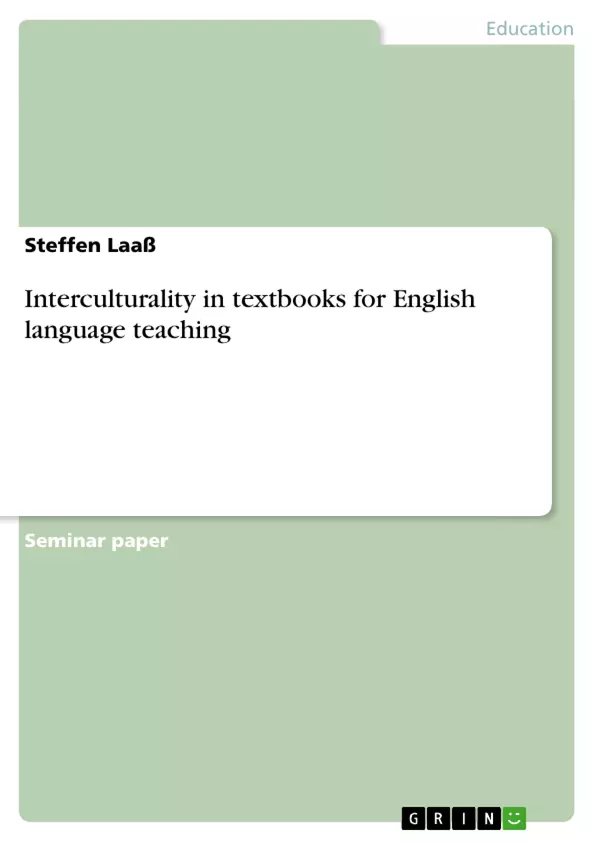Intercultural Learning and Intercultural Competence are ubiquitous buzzwords that have been used in the sphere of English teaching and learning for more than two decades now. It has been recognized that modern language teaching goes far beyond the acquisition of grammar and vocabulary alone. As students progress in their study of the foreign language, it is expected that they extend their knowledge and broaden their awareness about the target culture’s characteristics and peculiarities.
Theoretically, the creative implementation of Intercultural Learning could, if intelligently put into practice, have also led to an ‘overthrow’ of outdated teaching methods that, as a rule, emphasise pure cognition rather than communication or interaction. Unfortunately, the initial euphoria has gone and only little has changed in German classrooms. Still, interculturality is often taught in a way that appears uninteresting and ineffective, that is mainly based on facts and figures, and therefore rendering English sometimes not particularly popular as a subject among students.
The reasons for this situation are manifold. Teachers (and students) know too little about Intercultural Learning because it is a concept too fuzzy, vague, abstract and indefinite so as to be grasped immediately. It may also be due to the apparent lack or shortage of suitable learning and teaching materials that can be used in day-to-day school life. Luckily, current textbooks increasingly include creative aspects of interculturality. But how useful and fruitful are these modest ‘intercultural elements’ in practice?
In this paper, I will analyse two German textbooks used in institutional English teaching and learning nationwide and scrutinise them from an intercultural point of view. Before that, I will carry out a brief but thorough investigation into the notion of ‘Intercultural Learning’ (abbreviated to IL). I will then look into general functions of school textbooks as the primary teaching instrument, followed by a critical description and analysis of Green Line 5 (Klett) and English G 2000 D5 (Cornelsen).
Inhaltsverzeichnis (Table of Contents)
- Introduction
- What constitutes Intercultural Learning? A brief theoretical digression
- The role of the textbook in EFL-teaching
- Interculturality in EFL-textbooks
- Preliminary remarks on the analysis of interculturality in textbooks
- Textbook analysis 1 – Green Line New 5 (Klett)
- Textbook analysis 2 – English G 2000 (Cornelsen)
- Concluding remarks
- Bibliography
Zielsetzung und Themenschwerpunkte (Objectives and Key Themes)
This paper analyzes two German textbooks used in institutional English teaching and learning nationwide from an intercultural perspective. It examines how these textbooks incorporate intercultural aspects into their content. The paper also explores the theoretical framework of Intercultural Learning, including its definition, objectives, and importance in modern language teaching.- Intercultural Learning and its definition
- The role of textbooks in intercultural learning
- The analysis of intercultural elements in EFL textbooks
- The relationship between intercultural competence and language acquisition
- The impact of intercultural learning on student development
Zusammenfassung der Kapitel (Chapter Summaries)
- Introduction: This chapter introduces the concept of Intercultural Learning and its relevance to English language teaching. It highlights the shift from traditional grammar-focused teaching methods to a more communicative and culturally aware approach. The chapter also acknowledges the challenges and opportunities of integrating intercultural learning into classrooms.
- What constitutes Intercultural Learning? A brief theoretical digression: This chapter delves into the theoretical underpinnings of Intercultural Learning, examining its definition, goals, and core components. It explores the relationship between Intercultural Learning and related concepts, such as intercultural communication, competence, awareness, and sensitivity. The chapter also discusses the importance of intercultural learning for fostering respect, curiosity, and a deeper understanding of different cultures.
- The role of the textbook in EFL-teaching: This chapter examines the role of textbooks as primary teaching tools in English as a Foreign Language (EFL) education. It highlights the significance of textbooks in shaping curriculum, providing structure, and supporting teachers and students in the learning process. The chapter also discusses the expectations and challenges associated with using textbooks effectively in EFL teaching.
Schlüsselwörter (Keywords)
This paper focuses on the application of Intercultural Learning in the context of EFL textbook analysis. Key terms and concepts explored include Intercultural Learning, Intercultural Competence, EFL textbooks, intercultural communication, cultural awareness, and the integration of intercultural elements in teaching materials. The analysis examines how these concepts manifest in specific textbooks and their implications for student development.- Quote paper
- Steffen Laaß (Author), 2007, Interculturality in textbooks for English language teaching, Munich, GRIN Verlag, https://www.grin.com/document/114244



